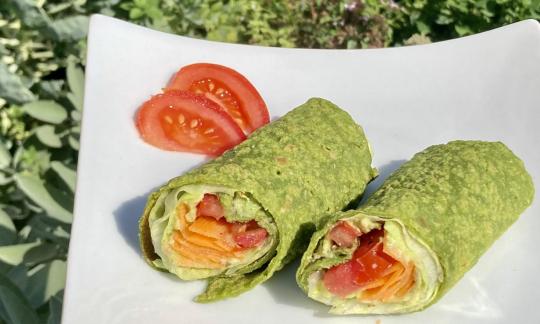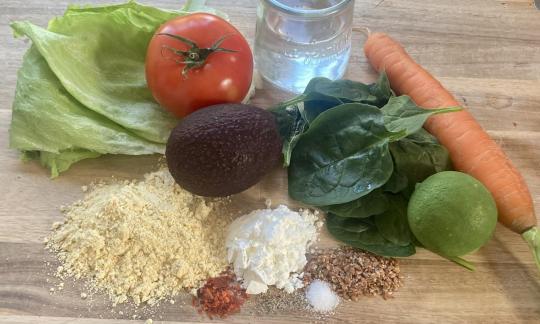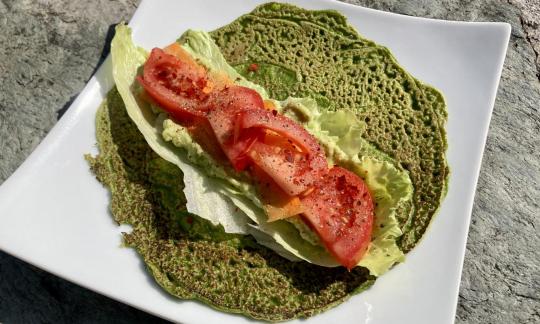Spinach and chickpea wraps with raw vegetable filling
vegan
Ingredients (for servings, )
| For the spinach chickpea wraps | |
|---|---|
| ⅔ oz | Spinach, raw (vegetable spinach) |
| 90 ml | Drinking water, raw (organic?) (3.2 oz) |
| 1 ⅜ oz | Chickpea flour (raw?, organic?) |
| ⅔ oz | Tapioca starch (organic?, raw?) |
| 1 ½ tsp, ground | Linseed, raw, organic? (golden linseed, flax) (0.13 oz) |
| 1 dash | Table salt (table salt, raw?, organic?) (0.01 oz) |
| For the guacamole | |
| 1 | Avocados, raw (organic?) (7.1 oz) |
| ½ | Limes, raw (organic?) (1.2 oz) |
| 1 dash | Table salt (table salt, raw?, organic?) (0.01 oz) |
| 1 dash | Black pepper (organic?, raw?) (0.00 oz) |
| ½ tsp | Chili flakes (raw?, organic?) (0.08 oz) |
| For the vegetable filling | |
| 1 | Carrots (carrots), raw (organic?) (2.1 oz) |
| 1 | Tomato, red, raw (organic?) (4.3 oz) |
| 2 leaves | Lettuce, (Butterhead group), raw, organic? (0.53 oz) |
Equipment
- blender or hand-held blender / immersion blender
- vegetable peeler
- skillet (frying pan)
- stove
- coffee grinder, electric
- citrus juicer (lemon squeezer)
Type of preparation
- fry
- chop or grind
- squeeze
- season to taste
- purée
- peel
- slice
Preparation
For the wraps
Put the spinach and half of the water in a blender and puree. Then add the remaining ingredients for the wraps and puree again until you have a smooth dough. If necessary, add a little more water so that the dough can be easily poured out and spread.As an alternative to a blender, you can also use a measuring cup and a hand blender.
We recommend grinding the flax seeds fresh before use, as the oils they contain spoil quickly.Heat a non-stick pan on the stove. Put a small ladle of batter into the pan and spread it thinly using a batter spreader (or by swirling). Fry for about 1 minute on each side until the batter is cooked but has only taken on a little color. Do the same with the rest of the batter. Put the finished crêpes aside.
A fairly flat crepe pan is best, but another, not too large and rather flat coated pan will also work.
The amount indicated for 6 portions corresponds to the amount of 6 medium-sized crêpes.
For the guacamole
Halve the avocado and remove it from the skin. Squeeze the lime. Puree the avocado with the lime juice using a fork. Season with salt and chili to taste.For the remaining filling
Wash the vegetables. Remove the stalk of the tomato and cut the tomato into half slices. Peel the carrot and slice it lengthways into thin slices using a vegetable peeler. Wash the lettuce leaves and pat dry.Finishing the wraps
Place one wrap on each plate. First place the lettuce leaf on the wrap and then spread the guacamole on the wrap. Then place the sliced carrot and the tomato pieces on top. Season with salt and pepper to taste. Roll the wrap up lengthways to the filling and then cut in half. Do the same with the other wraps and then serve.Filling: You can also vary the filling of the wraps. For example, you can use strips of pepper or cucumber or even quinoa or rice noodles. A Mexican filling with kidney beans and corn is also good.
|
Nutritional Information per person
Convert per 100g
|
2000 kcal | |
|---|---|---|
| Energy | 319 kcal | 15.9% |
| Fat/Lipids | 17 g | 24.6% |
| Saturated Fats | 2.4 g | 12.0% |
| Carbohydrates (inc.dietary fiber) | 38 g | 14.0% |
| Sugars | 6.8 g | 7.5% |
| Fiber | 12 g | 49.1% |
| Protein/Albumin | 8.3 g | 16.7% |
| Cooking Salt (Na:211.4 mg) | 537 mg | 22.4% |
| Essential micronutrients with the highest proportions | per person | 2000 kcal | |
|---|---|---|---|
| Vit | Vitamin K | 89 µg | 119.0% |
| Vit | Vitamin B9, B11 (Folate, as the active form of folic acid) | 212 µg | 106.0% |
| Elem | Potassium, K | 1'030 mg | 51.0% |
| Min | Copper, Cu | 0.48 mg | 48.0% |
| Vit | Vitamin A, as RAE | 363 µg | 45.0% |
| Min | Manganese, Mn | 0.74 mg | 37.0% |
| Vit | Vitamin C (ascorbic acid) | 29 mg | 36.0% |
| Vit | Vitamin B6 (pyridoxine) | 0.50 mg | 36.0% |
| Vit | Vitamin B5 (Pantothenic acid) | 1.7 mg | 29.0% |
| Fat | Alpha-Linolenic acid; ALA; 18:3 omega-3 | 0.59 g | 29.0% |
Detailed Nutritional Information per Person for this Recipe
The majority of the nutritional information comes from the USDA (US Department of Agriculture). This means that the information for natural products is often incomplete or only given within broader categories, whereas in most cases products made from these have more complete information displayed.
If we take flaxseed, for example, the important essential amino acid ALA (omega-3) is only included in an overarching category whereas for flaxseed oil ALA is listed specifically. In time, we will be able to change this, but it will require a lot of work. An “i” appears behind ingredients that have been adjusted and an explanation appears when you hover over this symbol.
For Erb Muesli, the original calculations resulted in 48 % of the daily requirement of ALA — but with the correction, we see that the muesli actually covers >100 % of the necessary recommendation for the omega-3 fatty acid ALA. Our goal is to eventually be able to compare the nutritional value of our recipes with those that are used in conventional western lifestyles.
| Essential fatty acids | per person | 2000 kcal |
|---|---|---|
| Alpha-Linolenic acid; ALA; 18:3 omega-3 | 0.59 g | 29.0% |
| Linoleic acid; LA; 18:2 omega-6 | 2.5 g | 25.0% |
| Essential amino acids | per person | 2000 kcal |
|---|---|---|
| Threonine (Thr, T, irreversibly transaminated) | 0.18 g | 20.0% |
| Tryptophan (Trp, W) | 0.05 g | 19.0% |
| Isoleucine (Ile, I) | 0.16 g | 13.0% |
| Lysine (Lys, K, irreversibly transaminated) | 0.23 g | 12.0% |
| Valin (Val, V) | 0.19 g | 12.0% |
| Phenylalanine (Phe, F) | 0.17 g | 11.0% |
| Leucine (Leu, L) | 0.25 g | 10.0% |
| Methionine (Met, M) | 0.06 g | 7.0% |
| Vitamins | per person | 2000 kcal |
|---|---|---|
| Vitamin K | 89 µg | 119.0% |
| Vitamin B9, B11 (Folate, as the active form of folic acid) | 212 µg | 106.0% |
| Vitamin A, as RAE | 363 µg | 45.0% |
| Vitamin C (ascorbic acid) | 29 mg | 36.0% |
| Vitamin B6 (pyridoxine) | 0.50 mg | 36.0% |
| Vitamin B5 (Pantothenic acid) | 1.7 mg | 29.0% |
| Vitamin E, as a-TEs | 3.1 mg | 26.0% |
| Vitamin B1 (Thiamine) | 0.26 mg | 23.0% |
| Vitamin B3 (Niacin) | 3.1 mg | 19.0% |
| Vitamin B2 (Riboflavin) | 0.24 mg | 17.0% |
| Vitamin B7 (Biotin, ex vitamin H) | 5.0 µg | 10.0% |
| Essential macroelements (macronutrients) | per person | 2000 kcal |
|---|---|---|
| Potassium, K | 1'030 mg | 51.0% |
| Sodium, Na | 211 mg | 26.0% |
| Magnesium, Mg | 92 mg | 24.0% |
| Phosphorus, P | 167 mg | 24.0% |
| Calcium, Ca | 63 mg | 8.0% |
| Essential trace elements (micronutrients) | per person | 2000 kcal |
|---|---|---|
| Copper, Cu | 0.48 mg | 48.0% |
| Manganese, Mn | 0.74 mg | 37.0% |
| Iron, Fe | 2.5 mg | 18.0% |
| Zinc, Zn | 1.6 mg | 16.0% |
| Selenium, Se | 2.8 µg | 5.0% |
| Iod, I (Jod, J) | 2.8 µg | 2.0% |
| Fluorine, F | 41 µg | 1.0% |
The spinach and chickpea wraps with raw vegetable filling are wonderfully light, healthy and also very filling.
Nutrient profile: According to GDA guidelines, one portion of this dish covers more than the average daily requirement of vitamin K and folic acid. However, some of the heat-sensitive ingredients are lost during the cooking process, which slightly reduces the amount per portion. The ratio of omega-6 to omega-3 fatty acids is 4:1, which is within the recommended range.
You can find further information on this topic at the following link: Vegans often eat unhealthily. Avoidable nutritional errors.
Spinach: Spinach is rich in vitamins (especially β-carotene, vitamin C), protein and minerals. Although spinach has a high iron content among vegetables, the iron content is not exceptionally high. Despite the high oxalic acid content, consuming raw spinach in reasonable amounts is not harmful to health.
Chickpeas: Ground, dried chickpeas are a gluten-free flour alternative. They are high in energy, nutritious and balanced in their ingredients. They are particularly rich in manganese and folic acid. Due to their high fiber content, they also keep you full for a long time and are therefore good for losing weight. They also have a high protein content. Your organic Its water footprint is lower than that of lentils and dried beans. Its ratio of omega-6 to omega-3 fatty acids is 26:1, which is well above the recommended range of 5:1, which should be taken into account when preparing it. We have therefore added flaxseed to compensate.
Flaxseed: Flaxseed has a slightly nutty taste. The fat content of 40% contains around 50% of the polyunsaturated omega-3 fatty acid alpha-linolenic acid (ALA) and thus the highest concentration of omega-3 fatty acids of all known vegetable oils. By adding flaxseed we were able to improve the ratio of omega-6 to omega-3 fatty acids.
Avocado: The avocado has by far the highest fat content of all known fruits and vegetables. The fat is mostly unsaturated fatty acids, which have a positive effect on blood fat levels. Avocados do contain polyunsaturated fatty acids, but the omega-6 to omega-3 fatty acid ratio of 15:1 is unfavorable, which is why this should be corrected by adding other ingredients (here, linseed). The high proportion of indigestible fiber lowers cholesterol levels. Avocados also contain many valuable vitamins and minerals.
Tapioca starch: Tapioca is a relatively tasteless, purely plant-based, gluten-free food starch. The vegan starch is a byproduct of the production of cassava flour, which is obtained from cassava. It is used in the kitchen as a binding agent.
Preventing browning: It is advisable to process avocados immediately, otherwise they will turn brown. The cut causes a break in the affected cell walls, which exposes the escaping ingredients to the oxidation process. This in turn causes the flesh to turn brown. Adding lime juice, for example, prevents this, which is why you should add it immediately after removing the flesh.
Storage and ripening of avocados: Avocados are climacteric fruits, meaning they continue to ripen. If you store avocados with apples, for example, you can speed up the ripening process by using the ethylene gas that comes out of the apples. If the avocado skin gives way slightly when pressed, the fruit is ready to eat.
Reduce salt : We have deliberately not specified the amount of salt. The aim is to keep the salt content as low as possible without compromising on taste. Since salt requirements vary from person to person, it is best to decide for yourself. A good read on this topic is the book " Salt. Sugar, Fat ".
Filling: You can also vary the filling of the wraps. For example, you can use strips of pepper or cucumber or even quinoa or rice noodles. A Mexican filling with kidney beans and corn is also good.








